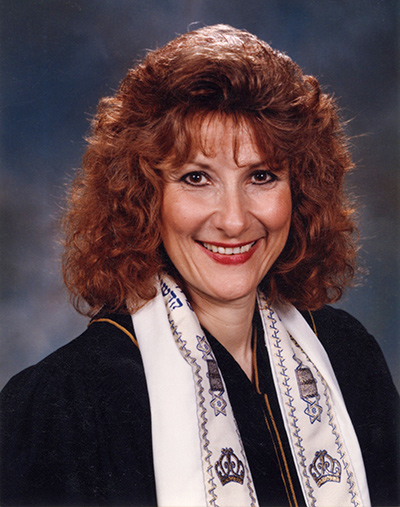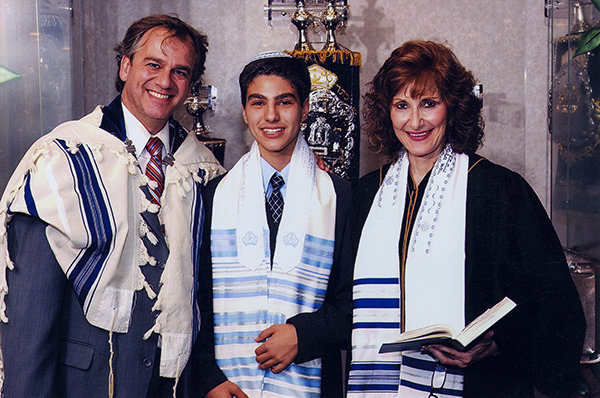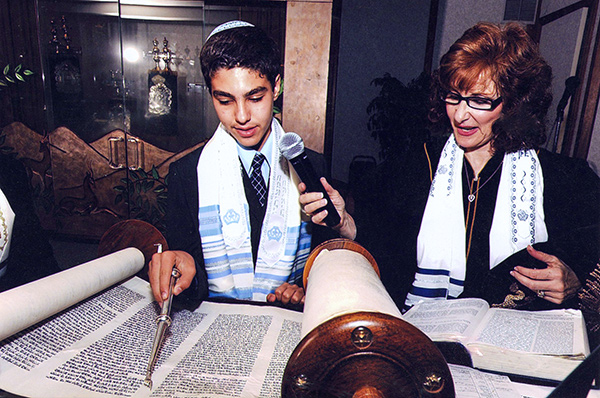Make the Sound Reach Heaven: An Interview with Linda Rich
Voices of Change: 50 Years of Women in the American Cantorate
by Judith S. Pinnolis
Linda Rich is a fifth-generation cantor and the first woman to serve as cantor in a Conservative congregation. A native of Los Angeles, Rich is an award-winning actress and served as the official cantor of the 1984 Olympic Games. She received ordination from the Cantors Assembly in 1996 (long after she had begun serving in a professional capacity) and served for many years at Temple Beth Zion in Los Angeles.
*This interview has been edited for clarity and length.
Your father and grandfather were both cantors. Tell us about your early life and how it was growing up in a cantorial family.
I was born in Boyle Heights in East Los Angeles. My parents were Cantor Israel Reich and Jeanne Fenichel Reich, both of blessed memory.
I am a fifth-generation cantor, as are my brothers, Barry and Brian, in Northern California. My father was the fourth generation. As for my grandfather, I didn’t really know him, but he emigrated from Europe around the turn of the century. My great grandfather was a khazn and a shokhet. He would be the second generation. I don’t know anything about the first generation.
Tell us about your father’s career as a cantor.
My father was actually a wunderkind. When his family came to the United States from Europe, they ended up living in tenements in the Bronx. He had seven or eight siblings and two or three of his brothers were cantors as well. He started singing professionally when he was around ten years old and pretty much supported the family concertizing throughout New York. He sang in Yossele Rosenblatt’s choir. His colleagues included Richard Tucker and Jan Peerce, who were older than him but also boy cantors.

Cantor Israel Reich (middle) and choir at the Breed Street Shul in Los Angeles, California, late 1940s.
The first position he got when he left New York was in San Francisco at Congregation Beth Shalom. He was commissioned to the Breed Street Shul in Boyle Heights around 1946. I believe Cantor Pierre Pinchik preceded him there. It was the heyday of Jewish life in Boyle Heights, but it was winding down and Jews were beginning to move west into the Fairfax district. By this time, my two brothers and I had been born. The family stayed in Boyle Heights until about 1953 when we moved to the Fairfax district (Temple Israel on Beverly Boulevard). From there it was on to Miami Beach, Florida, to Temple Emanuel, the largest conservative congregation in the country at the time. After four years, we moved back to Los Angeles (Congregation Magen David on Pico Boulevard). It wasn’t long before the family was off again to Youngstown, Ohio and then Seattle, Washington, finally settling at Beth Sholom in San Francisco, coincidentally, the same synagogue where my father began his career so many years before. And that’s where he stayed for 25 years until his retirement.
What type of choral music did you perform with your father?
My father loved the choral music of Paul Discount and Louis Lewandowski. So did I and I used that same music quite a lot in my career as well. My dad was a wonderful conductor, and I learned a lot about choral conducting from him.
What kind of music education did you have aside from learning cantorial music and singing in synagogue?
Well, of course, there was always singing and music playing in my home, as you can well imagine. My father was an excellent pianist and played violin as well, besides having perfect pitch. He taught me classical piano from the age of eight, and the family always sang at home. When we moved to Seattle, my dad needed a choir. So, I sang soprano, Barry sang tenor, Brian sang bass, and my father took the alto part. Some years after my father passed away, my daughter Rachel, began singing with us in concerts.
That’s essentially how my career started. I just started singing in choir and fell in love with the music. It really wasn’t until I got to college that I started studying music formally and discovered a whole new world. I discovered musical theater and auditioned for the Sally Bowles role in “Cabaret.” I didn’t know my stage left from stage right, upstage from downstage, but my director taught me everything, and I fell in love with theater, too. That’s what I thought I’d be doing for a career. I went on to do repertory theater and got a scholarship to study at the American Conservatory Theater in San Francisco.
Cantor Rich sings Moshe Koussevitsky’s Uv’div’rei kod’sh’cha on the 1983 album of cantorial music she recorded with her father and two brothers.
How did you become a cantor?
I did not grow up wanting to be a cantor. I was very shy, partly because we moved around so much.

Cantor Linda Rich
In 1973, I had an opportunity to audition for a musical theater workshop at the Dorothy Chandler Pavilion. My grandparents were living in Los Angeles, so I stayed with them. My grandfather said, “You have three weeks to sleep on my couch, and then you get a job.” I guess he was afraid I’d never leave!
After a while, I began singing for Jewish organizations in L.A., singing musical theater, Hebrew and Yiddish songs, accompanying myself on guitar and sometimes piano. Eventually, I teamed up with Jack Bernardi (Herschel Bernardi’s brother), and we started doing Yiddish music concerts. Somebody heard me sing one night and said, “You know, there’s a temple in a Laguna Woods retirement community that needs a cantor, just for Friday nights—why don’t you go try out?”
I auditioned and, to my surprise, I got the job. I remember when I got up on that pulpit, something changed in me. I felt that I belonged there. And from then on, I knew what I wanted to do with my life.
I began studying with Cantor William Sharlin. He was a wonderful, sweet master teacher, and he taught me a lot about music in the Reform movement. I occupied several positions in the Reform community: Temple Beth Tikva in Fullerton and Temple Menorah in Redondo Beach. In 1978, I heard about a Conservative congregation looking for a cantor. So I told my colleagues and my friends and family that I was going to try out for it. And they said, “Well, you’re a woman.” To which I answered, “And your point is?”
The rabbi at that congregation, Rabbi Edward Tenenbaum, had three daughters. He allowed me to audition, didn’t think twice about it. And I guess I never thought twice about it, either, because I grew up with two brothers and I never thought there was anything I couldn’t do if I wanted to.
“I remember when I got up on that pulpit, something changed in me. I felt that I belonged there.”
I was quite familiar with the Friday night liturgy. However, Saturday morning was a little different, especially in a Conservative congregation. So, I consulted some of my male cantorial friends. I only had a couple of weeks to prepare, but I learned the nusaḥ and all the prayers, auditioned, and got the job. And that’s when I knew I really had to start seriously studying, so I started studying with Cantor Allan Michelson to learn more about music in the Conservative movement. I took the exam to enter the Cantors Assembly in 1996 and aced it even though I never had formal training.
I stayed at Beth Zion for about six years and then moved to Burbank’s Temple Emmanuel, where I met my husband, in 1988. And then from there I went to Temple Ramat Zion in Northridge, Temple Aliyah in Woodland Hills, and finally Temple Ner Maarav in Encino with Rabbi Jason Van Leeuwan. That’s where I retired in 2012 and I’m now pursuing my acting career, having come full circle—although, I do sometimes take High Holiday positions.


Cantor Rich with Rabbi Jason Van Leeuwan rehearsing for a bar mitzvah at Temple Ner Maarav, Encino, California.
Tell us about the training you got with Allan Michelson.
Allan Michelson was a fantastic cantor in the old tradition, kind of like my father. He had this magnificent tenor voice. He was tough. But he could see the potential in me. Listening to my father all those years, I just sort of absorbed a lot of the older style of ḥazzanut with the coloraturas and that kind of stuff. We worked on pieces by Moshe Koussevitsky, Yossele Rosenblatt, and other cantors from the golden age of ḥazzanut. I just loved it. I also loved the newer, more “camp-style” music and learned quite a lot from attending camp Oconomowoc, a Reform camp in Wisconsin. Also, when we lived in San Francisco, I got to know Rabbi Shlomo Carlebach and attended his House of Love and Prayer. I fell in love with his music and his style of involving everyone in singing together and incorporated his music, along with traditional ḥazzanut into my services, which gave me a well-rounded repertoire.
Cantor Rich sings Leopold Edelstein’s Sim Shalom before a live audience, accompanied on the piano by her father, Cantor Israel Reich.
It was very moving to hear how you’d been on stage many times, but when you got up to sing as a cantor for a service, you found that that had a different meaning for you. Could you talk a little bit about the rewards of being a cantor?
I really think it was bashert. I think that everything that I did in my life brought me to that moment that Friday night when I first sang as a cantor. I think I was always meant to be a cantor. And even though I started out as an actress, I can’t imagine my life being as full and my career being as rewarding if I had gone into acting. It’s a wonderful craft and it’s fabulous, but there’s such a deepness to being a cantor.
One of the parts of the job that I really loved was working with b’nai mitzvah students. I worked with some kids who’s attitude was they were just doing this to please their parents or for the party. However, it was really gratifying, after the fact, to see how proud they were of their accomplishment and to realize that becoming a b’nai mitzvah had a deeper meaning behind it. Working with those kids was one of my favorite parts of the job. I also loved officiating at weddings and even being there for people in bereavement and doing funerals. It gave my life a lot of meaning that I don’t think I would have gotten in any other career.
Besides teaching for b’nai mitzvah, are there any special experiences that stand out for you?
“The role of the khazn is to make the sound reach heaven and reach our soul, and affect us and change us, and make us connected, l’dor v’dor, to our ancestors—and to those living now, and to those in the future, so that we’re a chain.”
When I was at Temple Ramat Zion, I was very happy to have a class of about thirty women that had never been b’nai mitzvah. One of the women in the class asked me one day, “When was your bat mitzvah?” I said, “Well, I didn’t have one.” So they said, “Why don’t you include yourself in the class with us?” So I did. I signed my own b’nai mitzvah certificate. Teaching them was very rewarding for me.
I also participated in a program through the Bureau of Jewish Education [currently the Builders of Jewish Education] where they brought in the children of Russian émigrés—kids that had never been b’nai mitzvah because they were not allowed to practice Judaism in the Soviet Union. And it was always very emotional and just a joy for them to see their children becoming b’nai mitzvah.
During my career I organized many cantorial concerts with local cantors. The ones I am most proud of were concerts that featured all women cantors. I was actually one of the first to have such concerts.
What you would like to see continue in cantorial music and what kinds of music do you see speaking to the current generation?

Cantor Rich, with daughter Rachel Reich Freed, Woodland Hills, California.
When I grew up, the cantor was the star. When he sang ḥazzanut, it moved you. These days, you rarely see cantors singing big pieces and the congregation just sitting and listening. It’s more participatory now, and congregational singing has nearly replaced more traditional davening. When Shlomo Carlebach and Debbie Friedman came along with music where you could sing along, that sort of replaced ḥazzanut. And, by the way, my father’s congregation in San Francisco was one of the very first congregations to embrace that—my father was very proud to have a singing congregation. But I think they both have a place in today’s world and I would really like to see more music from the golden age ḥazzanut. Because the role of the khazn is to make the sound reach heaven and reach our soul, and affect us and change us, and make us connected, l’dor v’dor, to our ancestors—and to those living now, and to those in the future, so that we’re a chain.
This interview is part of our Voices of Change: 50 Years of Women in the American Cantorate series.
